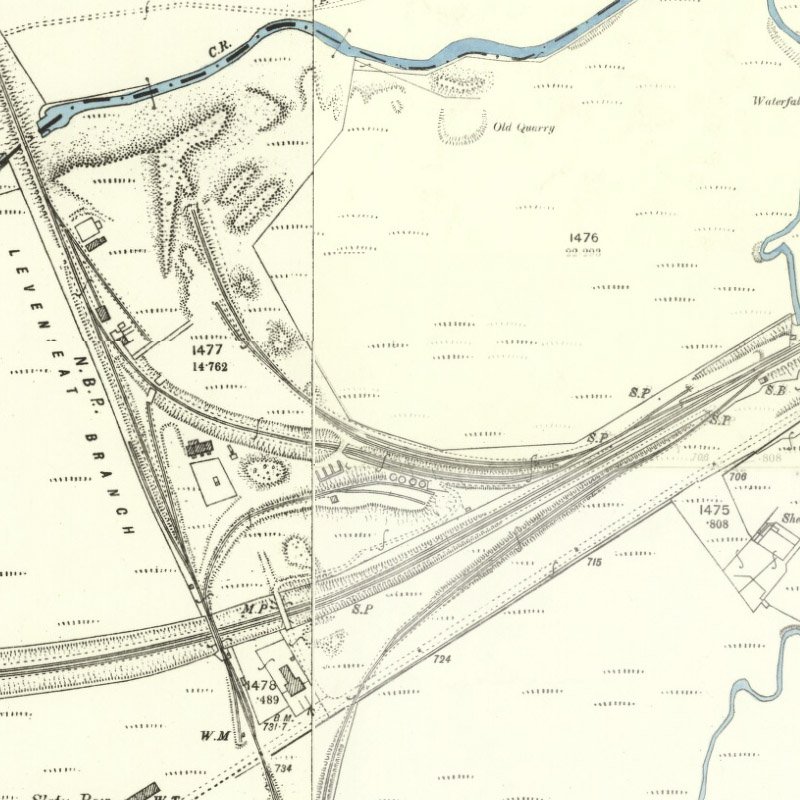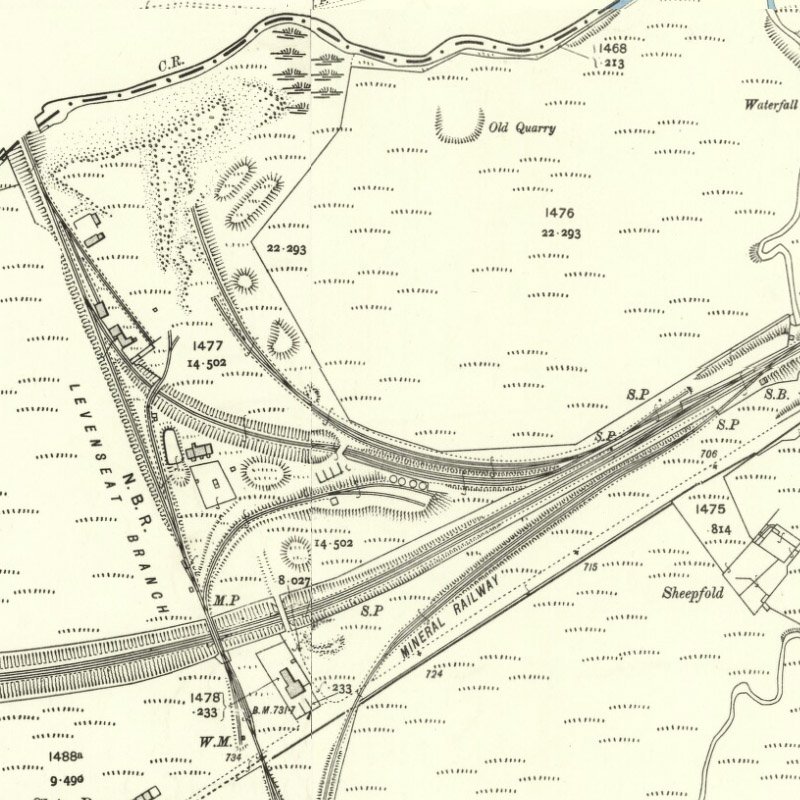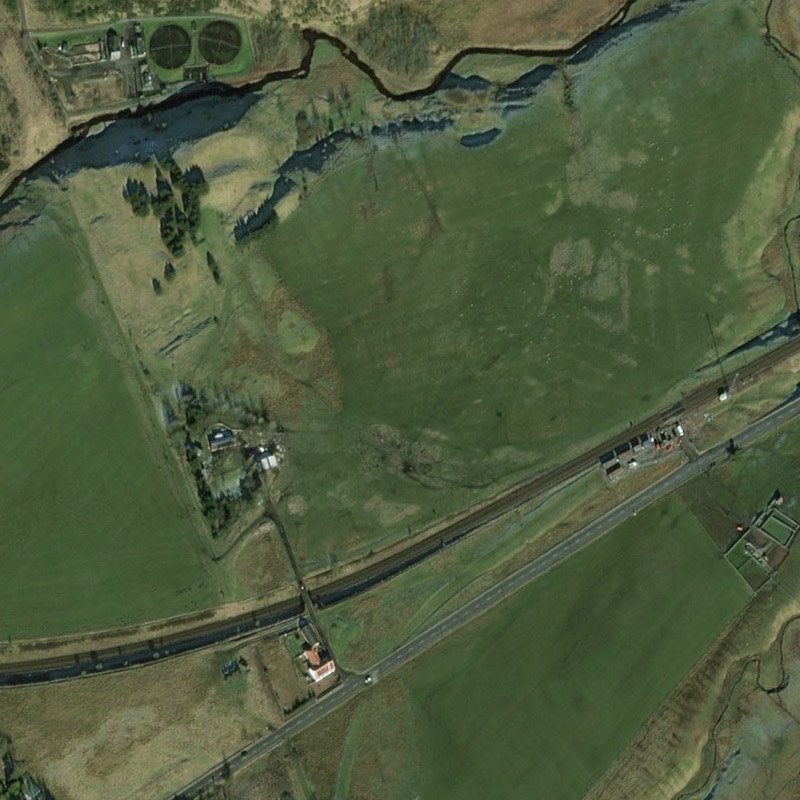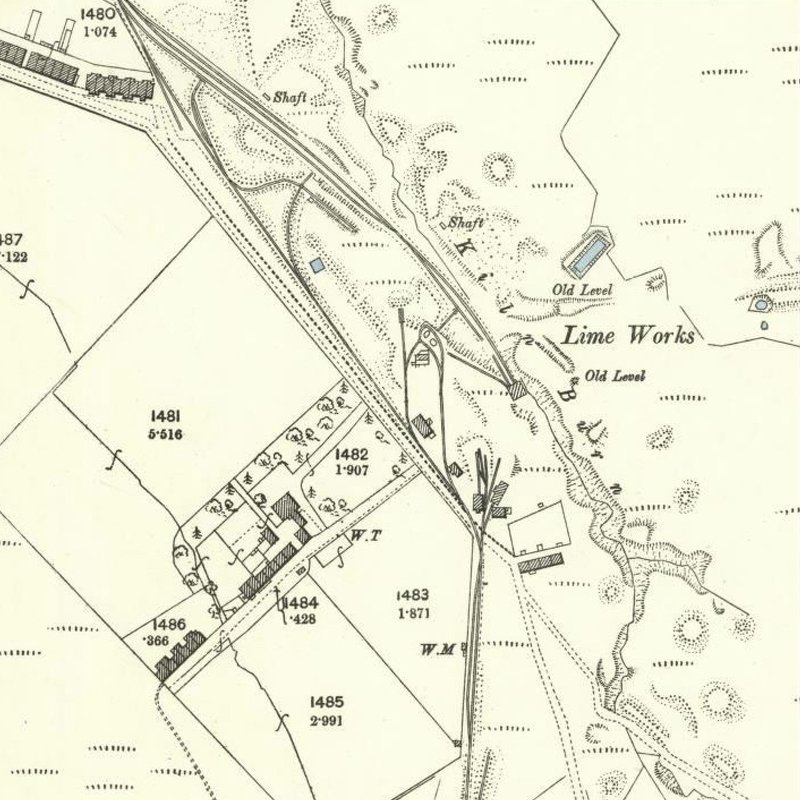- Aberdeen Oil Works
- Addiewell Oil Works
- Almondhill Oil Works
- Annick Lodge Oil Works
- Arden Oil Works
- Armadale Oil Works
- Auchenheath Oil Works
- Avonhead Oil Works
- Balgray Oil Works
- Ballat Oil Works
- Bathgate Oil Works
- Bathville Oil Works
- Bellsdyke Oil Works
- Bellsquarry Oil Works
- Benhar Oil Works
- Binnend Oil Works
- Birkenshaw Oil Works
- Bishop Street Oil Works
- Blackburn Oil Works
- Blackstone Oil Works
- Blackstoun Oil Works
- Blochairn Oil Works
- Boghall Oil Works
- Bredisholm Oil Works
- Breich Oil Works
- British Asphalte Oil Works
- Broxburn Oil Works
- Broxburn - Bell's Stewartfield Oil Works
- Broxburn - Albyn Oil Works
- Broxburn - East Mains Oil Works
- Broxburn - Greendykes Oil Works
- Broxburn - Hallfarm Oil Works
- Broxburn - Hutchinson's Oil Works
- Broxburn - Poynter's Oil Works
- Broxburn - Steele's Oil Works
- Broxburn - Steele's Stewartfield Oil Works
- Buckside Oil Works
- Burngrange Oil Works
- Calderbank Oil Works
- Canalbank Oil Works
- Champfleurie Oil Works
- Clippens Oil Works
- Cobbinshaw North Oil Works
- Cobbinshaw South Oil Works
- Coneypark Oil Works
- Craigie Oil Works
- Crown Point Oil Works
- Dalmeny Oil Works
- Deans Oil Works
- Doura Oil Works
- Drumbow Oil Works
- Drumcross Oil Works
- Drumgray Oil Works
- Dryflat Oil Works
- East Fulton Oil Works
- East Hermand Oil Works
- Eldin Oil Works
- Falkirk Oil Works
- Fergushill Oil Works
- Forthbank Oil Works
- Forth & Clyde Oil Works
- Gavieside Oil Works
- Grange Oil Works
- Grangepans Oil Works
- Greengairs Oil Works
- Hareshaw Oil Works
- Hartwood Oil Works
- Hawick Oil Works
- Hermand Oil Works (1866)
- Hermand Oil Works (1883)
- Holmes Oil Works
- Hopetoun Oil Works
- Hurlford Oil Works
- Inkerman Oil Works
- Inverkeithing Oil Works
- Kilrenny Oil Works
- Kilwinning Oil Works
- Kirkmuirhill Oil Works
- Kirkwood Oil Works
- Lanark Oil Works
- Lanemark Oil Works
- Levenseat Oil Works
- Limerigg Oil Works
- Linwood Oil Works
- Loanhead Oil Works
- Lochburn Road Oil Works
- Lochgelly Oil Works
- Longrigg Oil Works
- Magdalene Oil Works
- Methil Oil Works
- Millburn Oil Works
- Nettlehole Oil Works
- Niddry Castle Oil Works
- Nitshill Oil Works
- Oakbank Oil Works
- Palacecraig Oil Works
- Pathhead Oil Works
- Patterton Oil Works
- Pentland Oil Works
- Philpstoun Oil Works
- Port Dundas Oil Works
- Possil Oil Works
- Pumpherston Oil Works
- Raebog Oil Works
- Riggend Oil Works
- Rochsoles Oil Works
- Rochsolloch Oil Works
- Roman Camp - Almondfield Oil Works
- Roman Camp - Cawburn Oil Works
- Roman Camp Oil Works (1892)
- Roman Camp - Shale Oil Works
- Rosebank Oil Works
- Roughcraig Oil Works
- Rumford Street Oil Works
- Seafield Oil Works
- Shawsburn Oil Works
- Sheepford Locks Oil Works
- Shettleston Oil Works
- Shotts Oil Works
- Stand Oil Works
- Stanrigg Oil Works
- Stonehouse Oil Works
- Straiton Oil Works
- St. Rollox Works
- Swinehill Oil Works
- Tarbrax Oil Works
- Uphall Oil Works
- Uphall - Railway Oil Works
- Uphall - Wyllie's Oil Works
- Vulcan Chemical Works
- Wardend Oil Works
- Wattston Oil Works
- Westfield & Capeldrae Oil Works
- Westwood Oil Works (1941)
- Westwood Oil Works (1866)
- Whitebog Oil Works
- Whitehill Oil Works (Lanarkshire)
- Whitehill Oil Works (Midlothian)
- Whiterigg Oil Works
- Woodhall Oil Works
Levenseat Oil Works
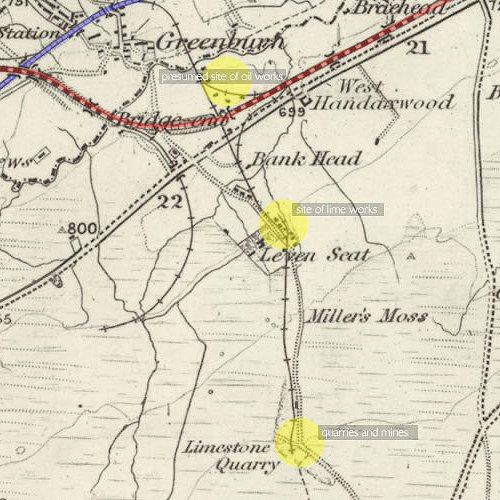
Best available evidence suggests:
- Leavenseat oil works were constructed in 1862 by A.M. Fell & Co. and supplied with shale from the nearby Levenseat lime works of George Gray & Co. A.M. Fell's involvement at Leavenseat appears to have been short-lived, turning his attention in 1863 to the formation of West Calder Oil Company and the construction of their Gavieside Oil Works.
- Between about 1866 and 1868, works were operated on a substantial scale by the Crofthead Oil Company, producing refined products including lamp oils. A fire at the refinery in January 1868 may have curtailed operations.
- George Gray & Co. appear to have taken direct control of the Leavenseat oil works in about 1869, investing substantially in new plant to produce a range of refined products. A new branch was constructed to link Leavenseat works with the North British Railway.
- In about 1873, Levenseat oil works were acquired by Thomas and James Thornton, who had a range of other coal and shale interests including Hermand Oil Works. Production of crude oil seems to have continued at Leavenseat until about 1884. On formation of the Hermand Oil Co. Ltd. in 1883, consideration was given to constructing a new refinery at Leavenseat, but the idea was never taken forward.
- New retorts seems to have built in about 1895 by the Leavenseat Oil Company, an organisation perhaps linked to the Pumpherston Oil Co. Ltd. Small scale production of grease and lubricants appears to have continued until about 1902.
Leavenseat oil works are not clearly identified on any Ordnance Survey map or other known plan, but are assumed to have been sited about a third of a mile north of Leavenseat lime works at 55.821270, -3.691128, between the Edinburgh-Ayr Road and the Briech water, and a little to west of West Handaxwood farm. The oil works appear to have been reconstructed on a number of occasions and referred to at various times as Leavenseat, Handaxwood, Crofthead, and Northern oil works. While all available evidence supports the idea that all oil operations took place at this single location, it remains possible that certain periods of activity could have taken place at different sites within the Levenseat area.
Background
Limestone, along with smaller quantities of ironstone and coal, were worked at Leavenseat from the late 18th century, initially supplying the Wilsontown ironworks, established 1779, which lay two and half miles to the south. In addition to supplying limestone for iron production, kilns at Leavenseat produced a lime that was highly regarded both as an agricultural fertilizer, and as a component in building mortars.
The first edition O.S. map, surveyed c. 1852, shows lime kilns at a site beside the kiln burn (55.815930, -3.685718) linked by a tramway to quarries and mines lying to the south, on the slopes of Leven Seat hill. Two rows of workers houses are marked close to the kilns, with a number of other rows in the general vicinity. By the second O.S. survey in c.1896, 60 men were employed in the lime works and further housing had been constructed, giving a dispersed village of 45 homes consisting of the Levenseat, Kiln, Engine, Hamilton, Store, Smithy and Oil Works Rows. This small community formed its own co-op, the Leavenseat Industrial Cooperative Society Ltd., which in 1898 boasted 69 members. The village also had its own primary school which continued until 1938, by which time it served only ten children.
Reserves of quality limestone seem to have been exhausted early in the 20th century, and by 1916, a newspaper account described a village in decline:
“Soon Leavenseat and its faded glory was gazed upon almost with sorrow. Once so bright and busy with men, women and children, carts, horses, and noisy little locomotives. Now only a few workmen, a small of evidence of industry and a number of dwellings becoming grey and old”
Subsequently a number of new mines were developed for the extraction of fireclay, which continued in operation into the 1960's. From about 1900, the Briech sandstone was quarried from an area immediately to west of the limestone workings. This soft rock continues to be crushed and washed at Levenseat to yield a silica-rich silver sand that is now used mainly for sport and horticultural purposes
Oil Production
The Levenseat limestone was about 9ft. thick, and was overlaid by a seam of shale 2ft. 3 in. thick, which included a 15 inch band of rich oilshale that could yield 33 gallons of oil per ton when retorted. These shales was usually extracted along with the limestone to ensure a sound roof to the workings, and seem likely to have been tipped as waste prior to the advent of the oil industry. Tough slabs of shale were sometimes used in the construction of drains and culverts.
Redwood lists an oil works at "Crofthead" as being active from 1850 to 1851 and describes it "of small account and only did business for barely a year". It might sensibly be assumed that the dates quoted should have read 1860 to 1861, and relate to the first phase of oil production at Levenseat, conducted by A.M. Fell & Co., who were quick to move their operations to Gavieside.
It seems that a substantial oil works and refinery were built at Levenseat in about 1865 by the Crofthead Oil Company. Nothing is known about this company, but it seems likely to have been associated with George Gray, proprietor of the Leavenseat lime works who would have supplied the oil shale. Gray had many local coal and mineral interests, including the Hillhouseridge (Shotts) oil works, constructed c.1865
A major fire at the oilworks in January 1868 destroyed much of the refinery, and subsequently George Gray was noted as proprietor of Leavenseat oil works, Under his ownership, the refinery was reconstructed and substantially enlarged, and Edmund Southby, previously of the Wareham Oil Works in Dorset, was appointed as oil works manager. The 1871 census records that "Handaxwood Manager's House" was occupied by Edmund R. Southby, described as an "analytical and manufacturing chemist (not practicing)", born in England. "Handaxwood works rows" were occupied by John Murphy, labourer, George Middlemass, retort keeper, while a third home was unoccupied. An advertisement appeared in The Scotsman on 2nd November 1869 seeking "a clerk for paraffin oil work". Applicants were to apply to "Mr. Southby, Northern Oil-Works, by Crofthead".
The oil works and lime works were connected to the rail network soon after opening of the Caledonian Railway's Cleland and Midcalder line in 1868, In c.1871 a two mile long line was installed to also link both works with the North British Railway's Morningside and Bathgate line at Crofthead. This seems to have been a private railway constructed by George Gray and included a major bridge across the Briech water. The line was later taken over by the North British Railway as their Leavenseat branch.
George Gray sold many of his business interests in 1872 and died in 1873.
Local coal and shale masters, Thomas and James Thornton, then purchased the limeworks and oil works at Leavenseat. Valuation roles suggest that crude oil production continued on a small scale and intermittent basis until about 1885 when the site was cleared. In the initial prospectus of the Hermand Oil Co. Ltd issued in 1883, (which aimed to consolidate the Thornton brothers' oil interests into a public company), it was proposed that a refinery might be erected at Leavenseat to process the crude oil manufactured at Hermand and Briech. Thomas died in c.1884, and James in 1885, thereafter the derelict site of Leavenseat oil works was held in trust by the family until about 1892.
A newspaper account of 1895 describes how an improved design of Pumpherston retort was to be introduced at a number of the Pumpherston Oil Co's works, and also at Levenseat. In the same year, the Leavenseat Oil Co. first appeared in Glasgow trade directories as "manufacturers of gas oil, hutch grease, &c" and continued to be listed in this way until 1903. The company is recorded as proprietor of Leavenseat oil works in valuation roles between 1895 and 1905, but the low rateable value suggests a very small scale operation, which seems strangely absent from the revised OS map surveyed in 1906
The Oilworks Site
The first edition of O.S. map, surveyed in 1852, shows little on the presumed oil works site other than a scatter of small mounds marked "refuse tips"; likely to be the abandoned remains of ironstone workings. The second edition O.S. map, surveyed in 1893, shows a landscape re-shaped by industry, most notably by mounds and waste tips extending northward into the valley of the Briech water. The small villa facing Ayr road was presumably the oil works manager's house (later known as Ayr Road house) while slightly to the north are the three homes of "Handaxwood works rows", later known as oil works rows.
The Caledonian Railway Cleland and Midcalder line (opened c.1869) lay in a cutting between these buildings, whilst the western boundary of the site was defined by the Leavenseat branch of the North British Railway. A line linking the two railways also crossed the site, with sidings serving other parts. A number of small buildings are shown associated with sidings on the Leavenseat branch, including one served by railway that might be a locomotive shed. Further to the east are marked four small circular structures, seeming too small to be oil tanks, and a small roof-less structure. It might be surmised that any significant building related to the oil works had been cleared at the time the map was surveyed and that little tipping of waste materials or other activities were taking place on the site at that time.
A revised survey dated 1906 shows appears little different, other than a short and tightly curved extension of one of the sidings, and certainly nothing that might indicate activity related to the operations of the Leavenseat Oil Co.
The Site Today
Today the oil works manager's house and the oil works row survive as private homes. The area of the site adjacent to the Cleland and Midcalder railway has been leveled and returned to agriculture, but most of the other landform of the oil works site remains as indicated on the 1906 OS map. The bing extending into the valley of the Briech Water is well covered with vegetation and trees, but still display at least six tip heads or tipping points. Where there are slippages of the bing, these reveal a black waste rather than the red blaes of most oilshale bings.
The former NBR Leavenseat branch continued to serve the sand works until c.1960, and most of the earthworks remain intact, although the bridges across the Briech water and the Cleland and Midcalder line have been removed
South of the A71 Edinburgh-Ayr road, the site of the lime works and kilns is marked by a series of grassed terraces either side of the kiln burn. A loading bank and other remains on the western side seem to relate to the 20th operations in which fireclay was transported by narrow-gauge railway from mines to the south. Most other industrial features in the lower parts of the site has been obliterated by ongoing sand quarrying operations, although Leavenseat house continues to provide a comfortable home. Higher up the slopes of Leavenseat hill, many of the quarries shown on the 1852 OS map remain intact, and a number of extend from the quarry face, and may be entered by the adventurous. The route of the early horse drawn tramway is clearly evident at these higher levels.
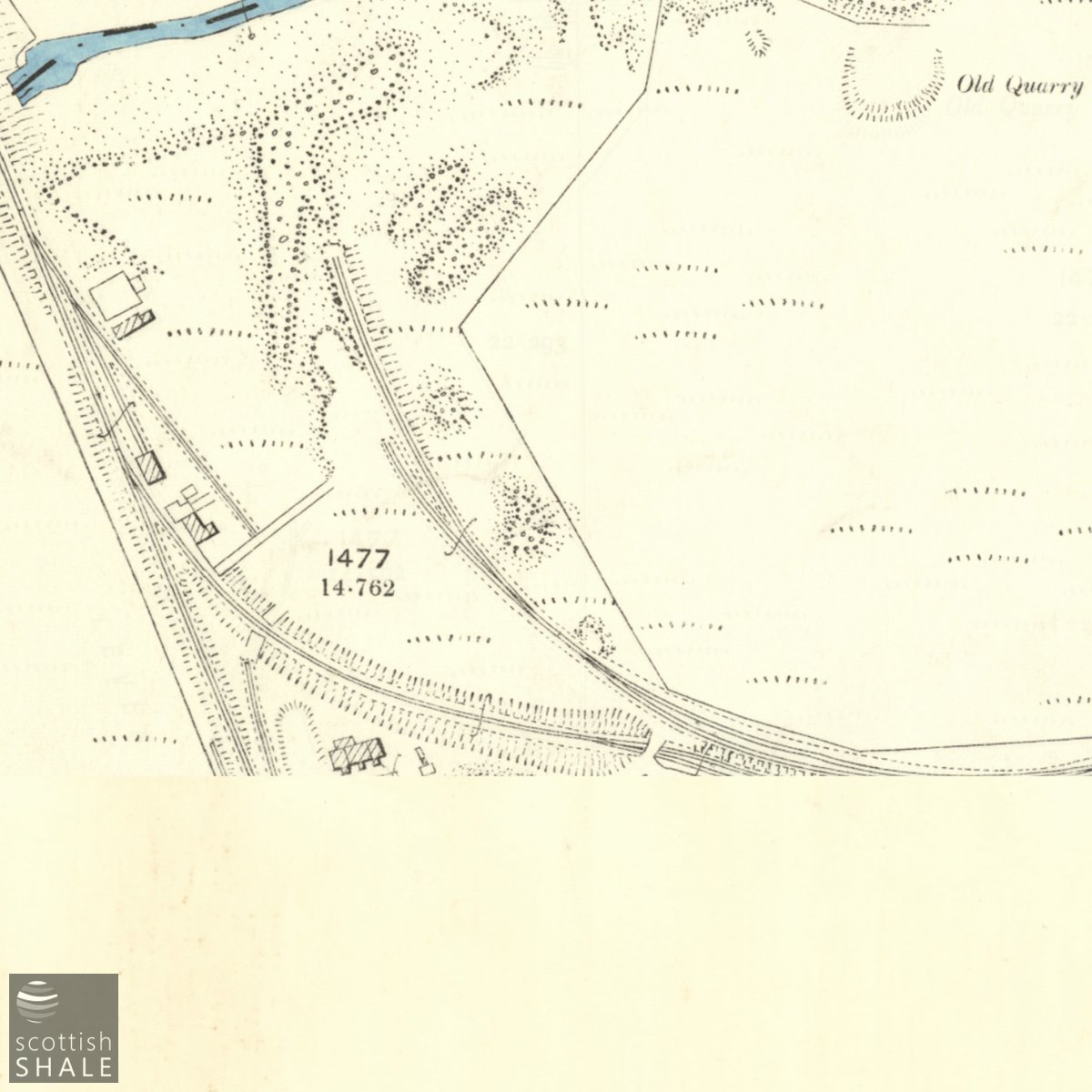
25" OS map c.1893, courtesy National Library of Scotland
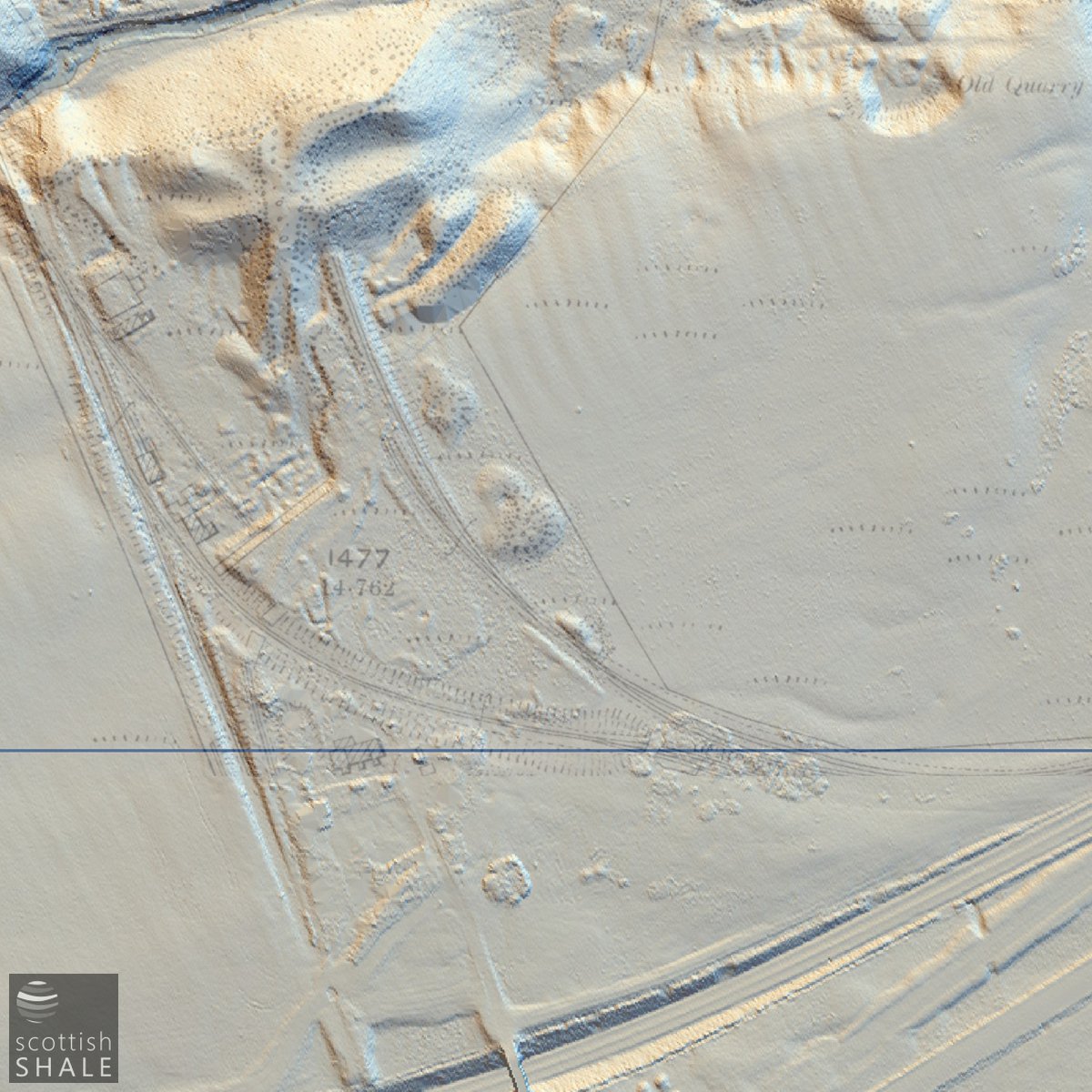
25" OS map c.1893, courtesy National Library of Scotland+ lidar image
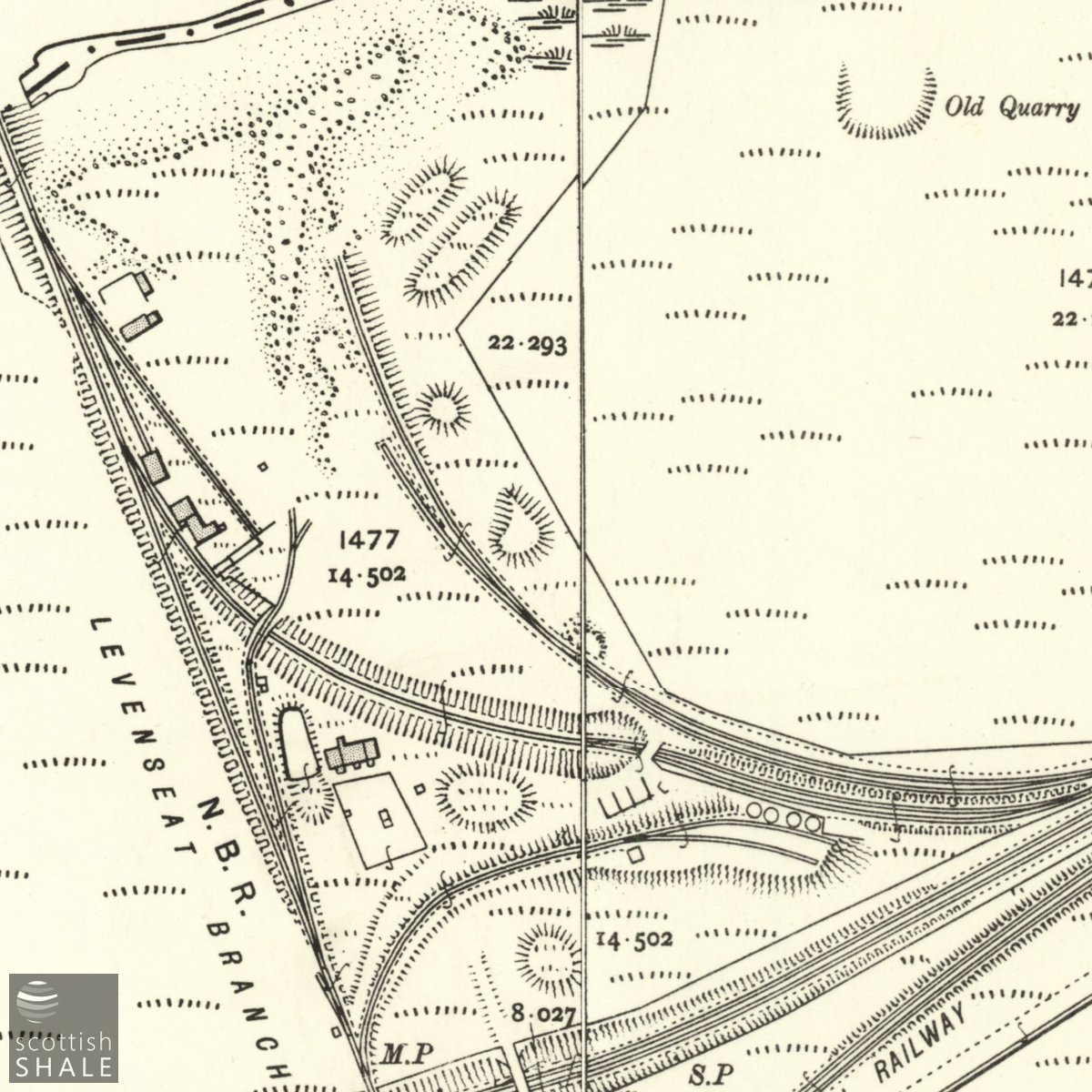
25" OS map c.1905, courtesy National Library of Scotland
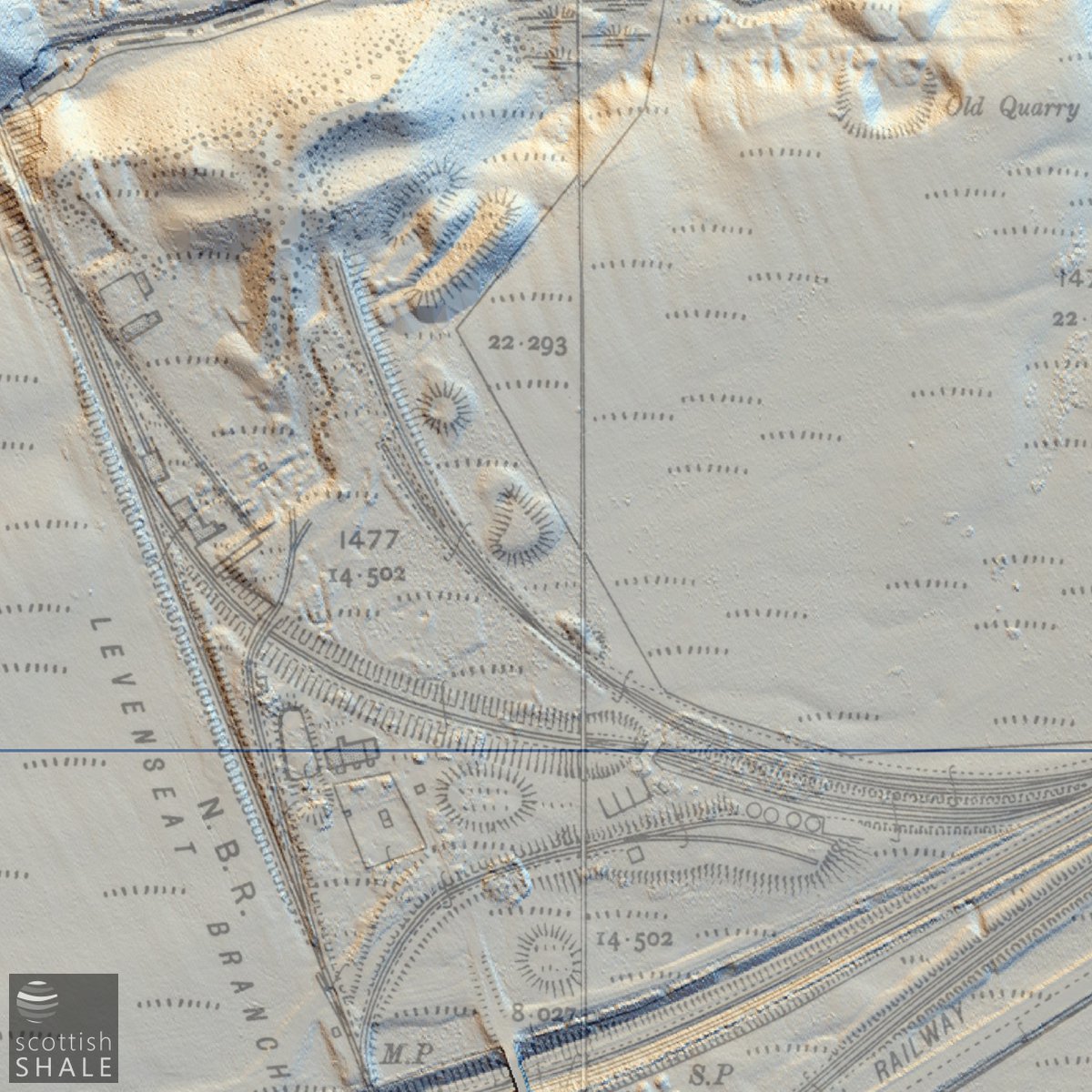
25" OS map c.1905, courtesy National Library of Scotland + lidar image

lidar image
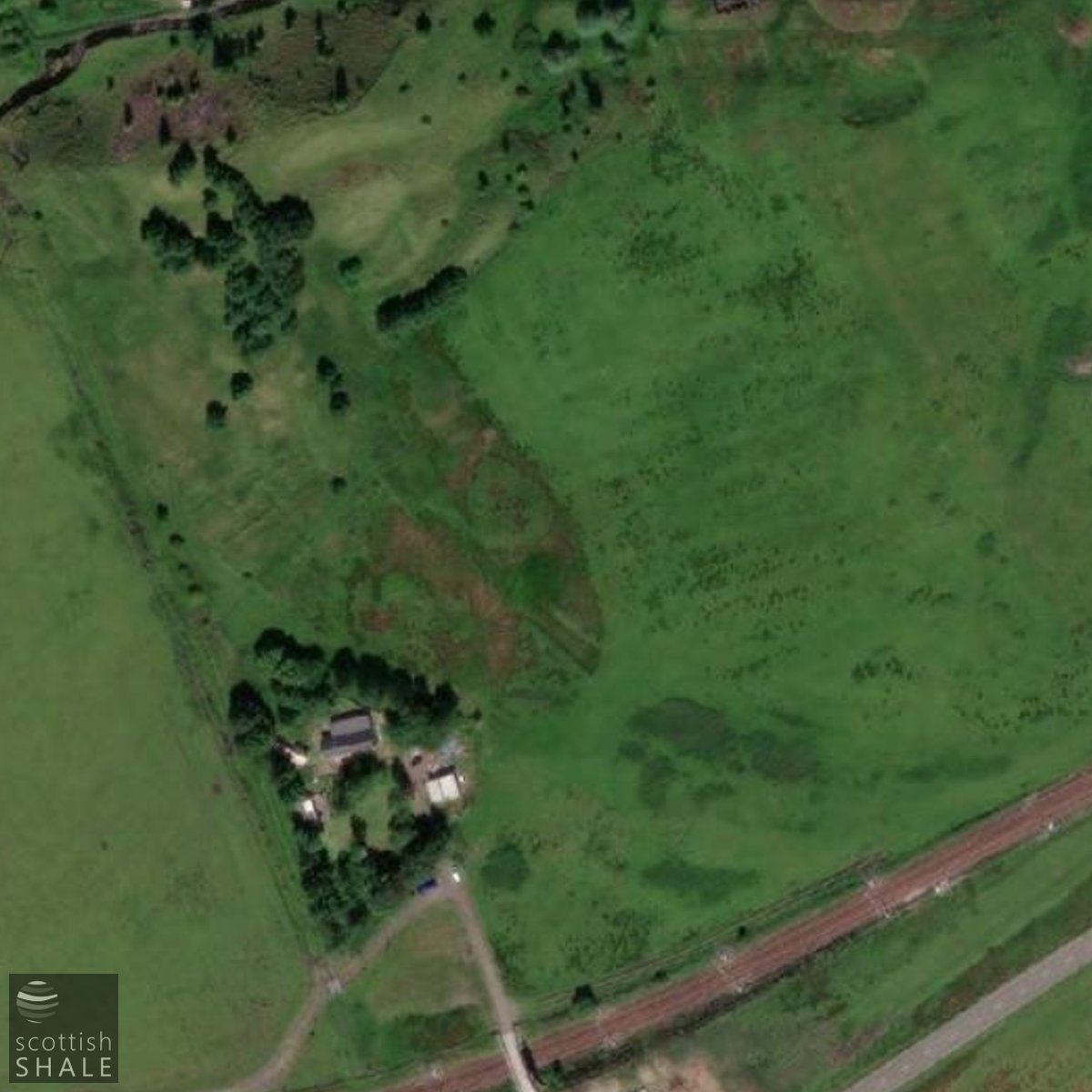
aerial image
Valuation Records
Entries between 1863 and 1903.
Valuation rolls for 1875 show Handaxwood Paraffin Oil Works, proprietors Thomas and James Thornton, annual vale £180 with manager's house and three houses.
Valuation rolls for 1885 show Handaxwood Paraffin Oil Works, proprietor James Thornton, annual vale £175, with manager's house occupied by John Crawford, clerk, and three houses occupied by Adam Howieson, miner; Robert Hayden, labourer; and William Davidson, joiner.
No records are shown in 1865 and 1895 but valuation rolls for 1905 list "Chemical works, Leavenseat Oil Co. per Robert Gray, 93 Hope St., Glasgow (partners Robert Gray & John Glen. Value £150".

Recent images
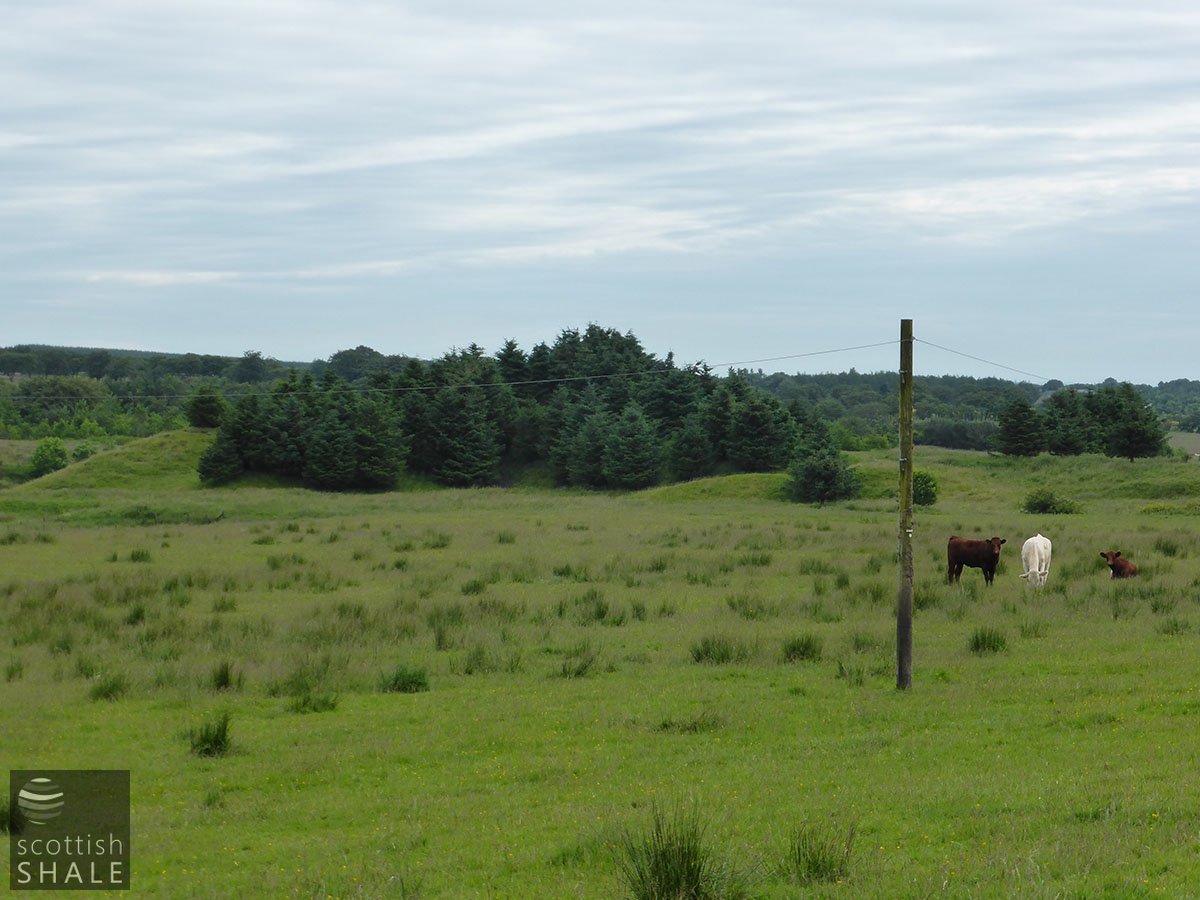
View across the top of the waste tips. Looking north east. June 2014.
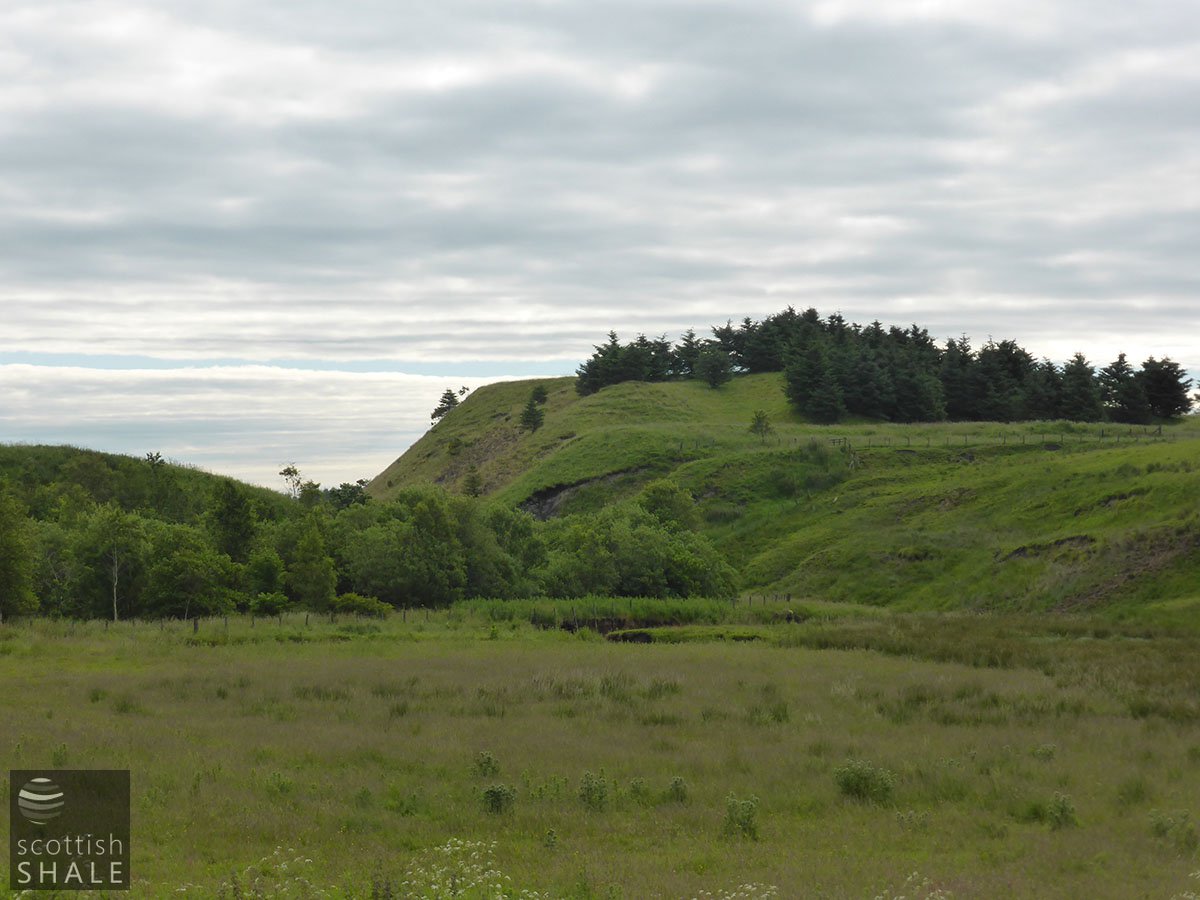
Former waste tips projecting into the valley of the Briech Water seen from the west. June 2014.
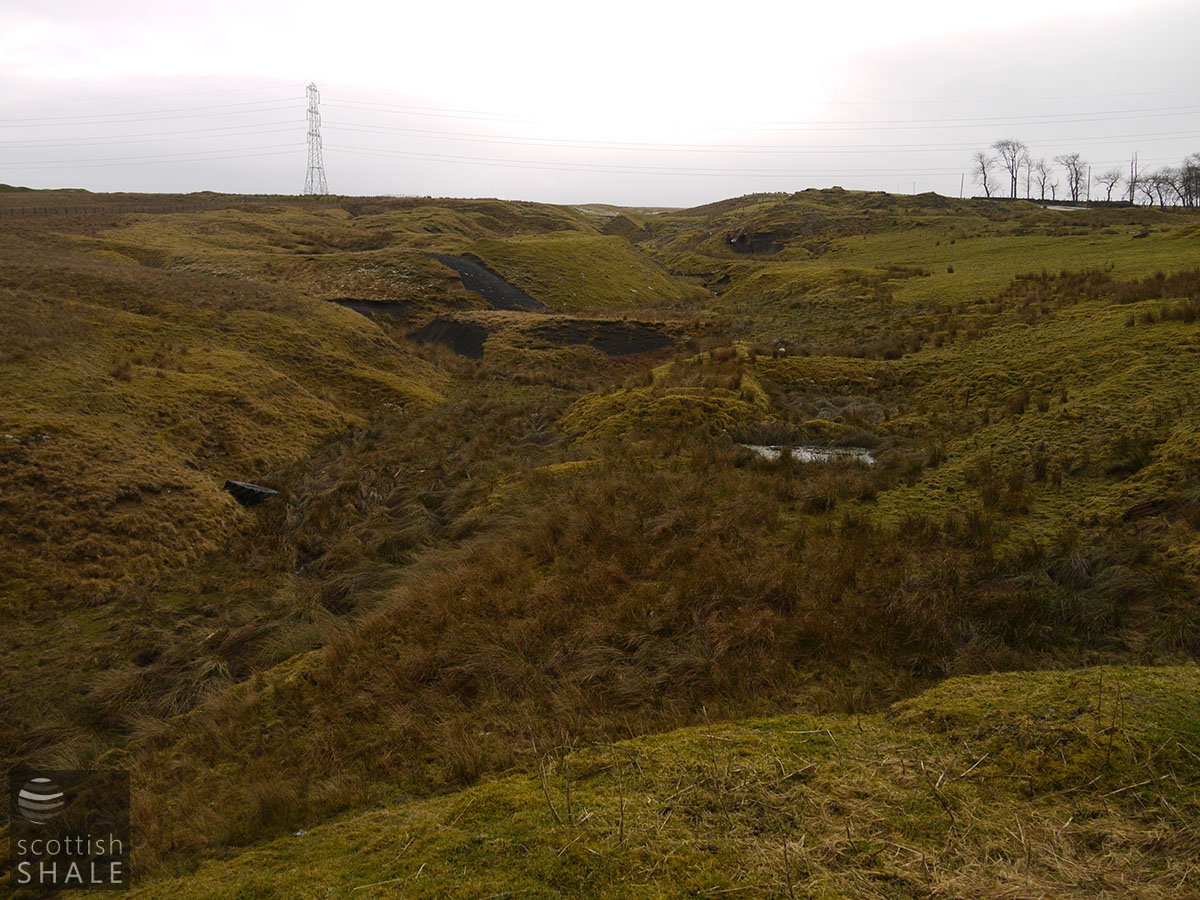
Southern limestone quarries, with tramway leading towards mine entrance. Looking south. December 2016.
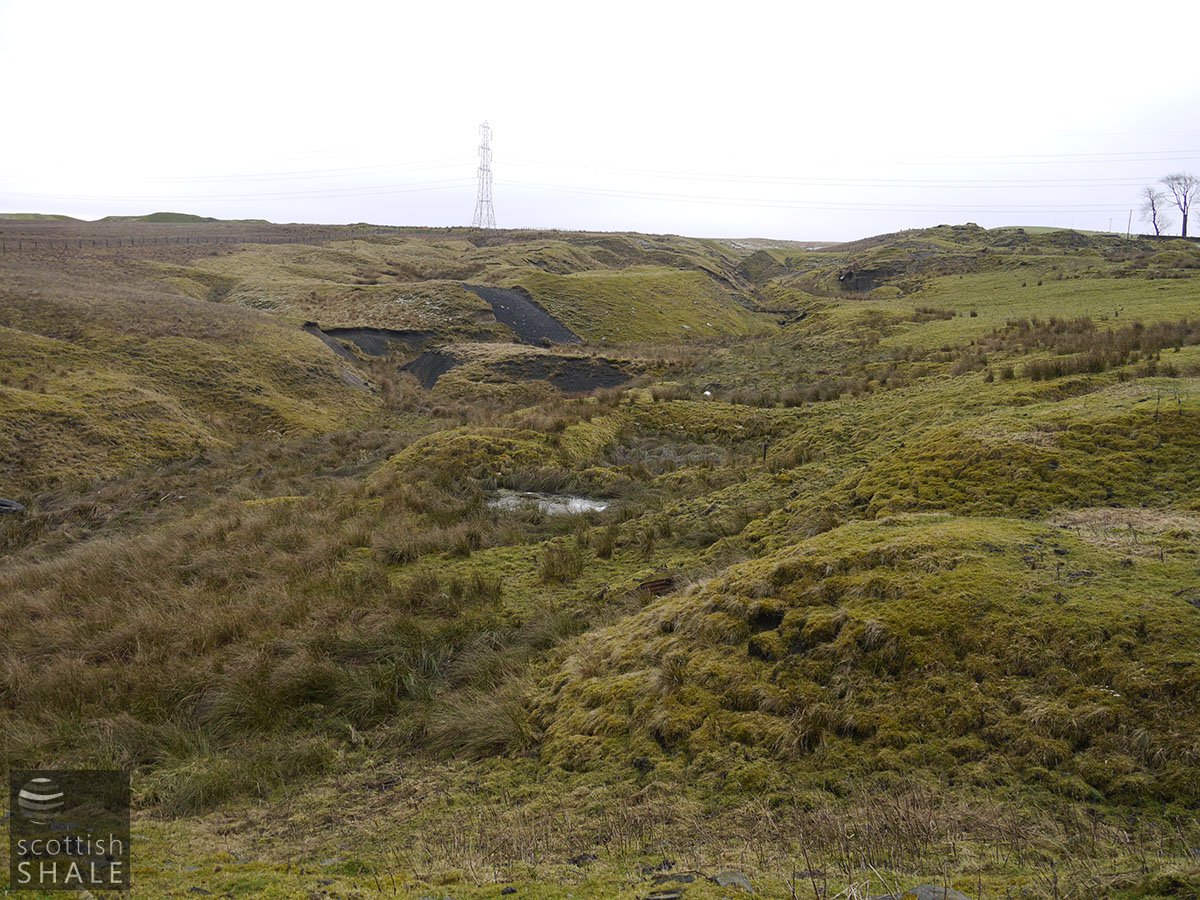
December 2016.
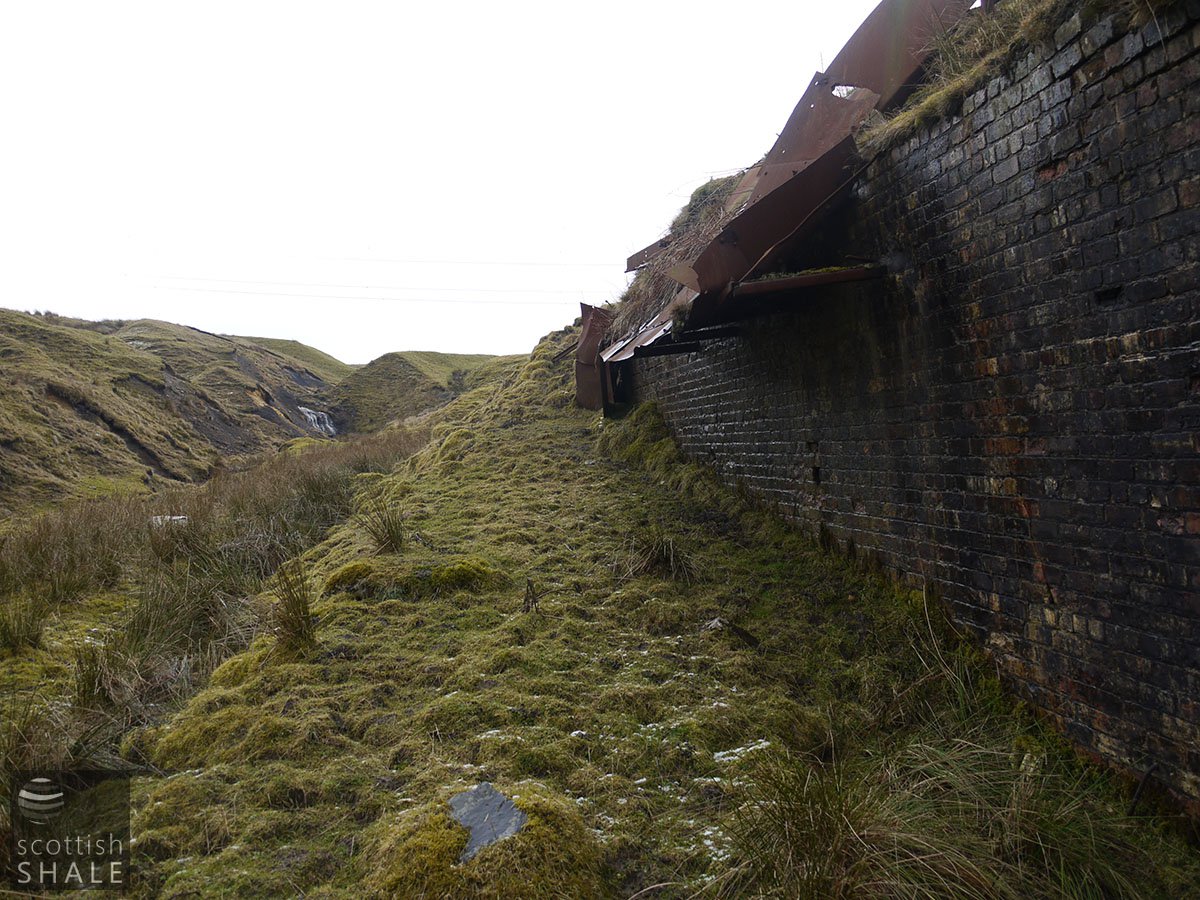
Loading bank, presumably where fireclay was loaded onto standard gauge wagons. December 2016.
BATHGATE. Manufacture of Paraffin. observe that a paraffin work on small scale is in full operation near Houston Station, on the Edinburgh and Bathgate Railway, and a Glasgow company, we understand, is about to start similar work Levenseat, to the south of Longridge, and in the parish of West-Calder. An immense quantity of shale has been purchased by the latter enterprising company, in order to carry out successfully this great undertaking.
Falkirk Herald, 1st May 1862
.......
Messrs Fell & Co., the enterprising proprietors of the chemical works at Levenseat, about three miles south west from West Calder, where the manufacture of crude oil from shale has been very successfully carried for some time, have, with the view towards erecting works of the same kind here (West Calder), sunk a shaft for the purpose of ascertaining the quality, and of working coal called the Houston smithy coal, to be used in the process of extraction. It is arranged, we understand, that thirty six retorts will be erected soon.
Glasgow Morning Journal, 3rd October 1862
.......
The 10th of March, 1863, was a great day at Crofthead....(in celebrating the wedding of the Prince of Wales)... the employees of the Oil Works (A.M. Fell & Co.) had a splendid supper and ball over at their works; the employees of G. Gray, Esq., Leavenseat Lime-works, had a supper and ball, they had also a large bonfire on Leavenseat hill.
Hamilton Advertiser, 14th March 1863
.......
Throughout the whole of her Majesty's dominions was not a more loyal and happy company than that assembled on the summit of Leavenseat hill on the 10th March. The hill was crowned by a very large, brilliant and conspicuous bonfire which far outshone the competitors in the neighbourhood. Being composed of coal, wood, and several barrels of shale oil, there was a brilliant illumination throughout the night of the 10th.....
....Mr. Gray caused the whole tent to be floored with wood, in a manner which might serve for the hall of a great city. The tent inside was brilliantly lighted up with lamps, filled with very superior shale oil which is manufactured at Leavenseat.
Glasgow Herald, 16th March 1863
.......
FOREMAN WANTED, for a Shale Oil Work, One who understands a little of the Refining preferred. Apply at Leavenseat Lime Works, near Crofthead, Whitburn.
Glasgow Herald, 29th November 1865
.......
CROFTHEAD – FIRE AT LEAVENSEAT OIL WORK.
The large oil work at Leavenseat, near Crofthead, was, about seven o'clock on Monday night, discovered to be on fire, and a great amount of valuable property was destroyed before the flames were got under. It is supposed that the fire originated in the overflowing of a still, the oil which escaped therefrom having caught fire at the furnace-doors. Great exertions were made to subdue the fire before much damage had been done; but, as no fire-engine could be got, and there were was an insufficient supply of water, these were not to any considerable extent successful. A large quantity of paraffine oil – both refined and crude – and variously estimated at from 14,000 to 18,000 gallons, was consumed. The refining house was burned almost to the ground.
Scotsman, 24th January 1868
.......
Caledonian Railway, The Cleland and Midcalder Line - In addition to those at West and Midcalder, the oil works at Linnhouse. Hennand, Handaxwood and Dykehead…………. Which, though not connected, are within a stone's throw almost of the line.
Falkirk Herald, 3rd December 1868
.......
Previous to the expiry of the coal oil patents in 1864, and some years before Addiewell Works were commenced, several works were active in distilling oil from shale. In the parish of West-Calder, a seam of shale lying on the limestone on the estate of Mr. Hare of Calderhall was worked by Mr. Gray, and the shale distilled at the Leavenseat Oil Works.
Scotsman, 8th February 1869
.......
FOR SALE, THE following GOING COLLIERIES and WORKS in the Counties of Lanark and Linlithgow. ..... 2. THE LEVENSEAT SHALE and LIME WORKS, near Crofthead, with Branch Railways, Locomotive Engines, Waggons, and all requisite Plant. ….. For further particulars application may be made to Messrs. HILL, Reid, & DRUMMOND, W.S.; or to Mr GAVIN PAUL; Wilsontown House, by Carnwath, with either of whom offers may be lodged up till 15th January 1869.
Scotsman, 9th January 1869
.......
Clerk – Wanted for a Paraffin Oil Work. Wages 21s., per week. One similarly employed will be preferred. Apply to Mr. Southby, Northern Oil-Works, by Crofthead.
Scotsman, 2nd November 1869
.......
CROFTHEAD. The shale oil trade – Extensive alterations are now being made at the Leavenseat Oil Works, near Crofthead. The refinery has been largely extended and improved, and all the requisites for an increased supply of oil – including stills, store tanks, washers and condensers – have been added to the works. One store tank alone has been fitted up which will contain 50,000 gallons of refined oil. The refinery is now capable of turning out the produce of from 50,000 to 80,000 gallons of Crude Oil monthly. The new works and extensions have been carried out by the Airdrie Iron Company.
Falkirk Herald, 25th June 1870
.......
The mineral oil trade has commenced to supply winter orders, and additional means of expediting the export are being made, amongst which might be noticed the formation of a new railway from Leavenseat Oilworks to Crofthead, on the North British branch of the Morningside and Bathgate line, which will be about two and a half miles in length.
Scotsman, 31st October 1870
.......
Leavenseat Lime and Oil Works – Contract for Railway Works.
Tenders are invited for the Earthwork, Masonry, Ballasting, Rail-Laying, the construction of two bridges and other works necessary in forming Branch Railway between the North British, Morningside and Bathgate Line, at Crofthead Station, and the above works. The Total Length of Line, including sidings, is 2 miles, 560 Yards.
Glasgow Evening Post, 2nd November 1870
.......
The mineral oil trade is exceedingly brisk and, notwithstanding the great quantities being imported from the great American fields, the Bathgate Works, the Levenseat Works, and the Stanrigg Company are forced night and day to complete their contracts.
Scotsman, 14th November 1870
.......
CROFTHEAD. Serious Railway Accident.-Allan Aitken, a labourer about fifty-five years of age, and residing at Shepherd Hill, near Crofthead on Tuesday morning met with a very severe accident while going work at the Levenside Oilworks. He was the act of passing two manure waggons, which were standing on siding near the works, when some other waggons which had broken off from the main line an which he had not observed till the moment of collision, came into contact with the two standing on the siding. One of the manure waggons was thrown off the line by the shock, and fell upon Aitken, breaking one of his legs, and otherwise severely injuring him about the chest and face. He was extricated from his position, and brought into the Royal Infirmary Edinburgh, where he lies now a precarious state.
Falkirk Herald 18th May 1871
.......
ROBERT MUIR vs. GEORGE GRAY.
This is an action for damages, arising out of novel circumstances, The pursuer, who resides at Levenseat, Edinburghshire, asks £6958, 0s. in name of damages for breach of agreement by the defender, coal-master Levenseat. In July the pursuer was engaged as manager of the defender's works and pits for four years. At that time the defender was the sole owner of Hartwoodhill Collieries, the Shotts Oil Works, the Levenseat Lime Works and the Levenseat Oil Works, and the pursuer was to receive £250 a-year, and certain percentages of the profits of the various works and pits. In July 1872, the defender sold Harwoodhill Collieries and the Shotts Oil Works to the Benhar Coal Company with the pursuer's knowledge or consent.
Scotsman, 29th January 1873
.......
Evidence of George Gray, Paraffin Oil Manufacturer, Leavenseat, by Greenburn, Edinburghshire. My works are situated on the Breich, a tributary of the Almond. Employ 8 hands. Rateable value of works, £265 15s. The bed of the stream is not silted up. My works are affected by floods. The stream is of a yellow dirty colour, and quite unfit for use. It is polluted seriously by works above and by mines. Obtain supply of water from limestone mines, but am not able to state the annual consumption at my works. Use yearly, bituminous shale, 7000 tons; sulphuric acid, 200 tons; and caustic soda or other alkali, 30 tons. Produce crude paraffin oil, 240,000 gallons; lubricating oil, 30,000 gallons; illuminating oil, 180,000 gallons; and solid paraffin, 50 tons. I am not able to state the volume of condensed water separated from tar after removal of naphtha. Produce 18,000 gallons of spend sulphuric acid after first purifying process, and 18,000 gallons of spent caustic soda and tarry matter after second purifying process. We recover the sulphuric acid and caustic soda and re-use them. Produce yearly 4000 tons of spent shale, which is deposited in a heap on our premises. Use steam, 30 nominal horse-power. Consume yearly 6000 tons of coal, the ashes from which are used for ballast on railways. The excrements of my workpeople are carried to the spent shale heap. Have no suggestions to offer.
Report on the pollution of Scotch rivers to the Rivers Pollution Commissioners, as reported in The Falkirk Herald, 28th August 1873
.......
The crude oil work at Leavenseat has been working until recently.... The (lime works) at Leavenseat in the west end of the parish seems rather an extensive work employing about sixty people, with steam appliances, and turns out about 55,000 tons per annum. The burned lime realises 8/- and the limestone 3/- per ton on railway waggon at the works. This limestone which is wrought from the surface and also by pit, averages 8 feet in thickness, with a shale of about one and a half feet above the lime.
History of West Calder, by a native (1885)
.......
Prospectus of the Hermand Oil Co. - It is also intended to erect Refining Works of the most improved description to refine the Crude Oil into its various products. These Works it is proposed to place either at Birniehill or Levenseat, near Fauldhouse, where the Company have the option acquiring a suitable site lands belonging to Mr James Thornton. Levenseat is within easy distance the proposed site of the Crude Oil Works, and has the advantages of abundant supply of water and separate connections with the Caledonian and North British Railways, as well ample house accommodation and cheap fuel.
Dundee Advertiser, 29th October 1883
.......
IMPROVEMENT IN OIL WORK RETORTS
Messrs J. Bryson, Pumpherston, J. Jones, Dalmeny, and W. Fraser, Glasgow, have made an improvement in retorts for the distillation of shale and other bituminous substances. The main object of the inventors, it is said, is to provide a retort which, after being heated and started, will require practically no fuel to keep it going. We understand that a new or improved retort is also being constructed at Leavenseat works, and at Seafield. We are further informed that it is intended to provide the re-constructed works at Deans, Bathgate, with one or more benches of the improved retorts to which we have alluded above. The results of future experiments will be awaited with interest by those engaged in the oil industry.
Falkirk Herald, 3rd August 1895
.......
The limestone, which is about 9 feet thick, is overlain by an oil shale 2 feet 3 inches thick, the lower portion of which is very thick and is mined together with the limestone. For many years this tough leathery shale was sold throughout a wide district for cover plates and for road culverts and, although less than 1 foot in thickness, these plates are so strung that heavy traction engines can pass over the culverts without breaking them ( pg. 113)
About forty years ago, when the oil companies first began operations, the oil shale at Leven Seat was retorted and refined in a small work near Greenburn. At that time the price of paraffin oil was high and the work proved remunerative. When prices first began to fall the refining was discontinued and the crude oil sold, but at about ten years ago the work was stopped entirely owing to the low price obtained. (pg.122)
Summary of Progress of the Geological Survey of the United Kingdom for 1904, published 1905


